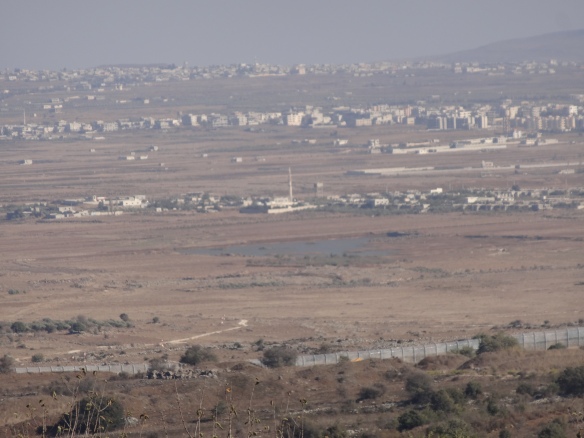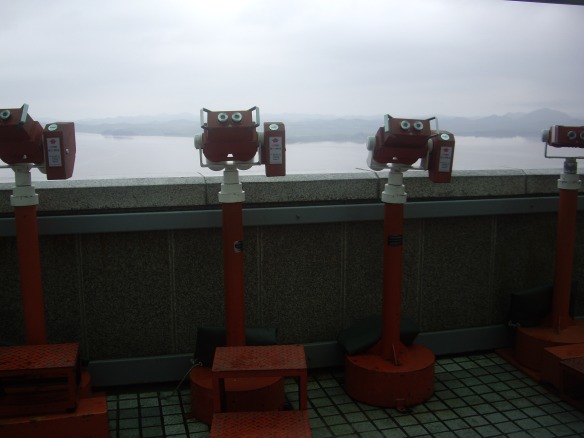
Vue de Kuneitra (Syrie) depuis le Golan, côté israélien. Depuis l’intrusion de l’Etat hébreu en 1967, le Golan est sous occupation israélienne.
Pour un rappel historique des faits et le poids des représentations géographiques des protagonistes, voir l’article de Michael F. Davies, géographe à l’université de Tours:
http://mappemonde.mgm.fr/num8/articles/art05404.html
Au premier plan, on aperçoit la zone démilitarisée avec la barrière de séparation.
La guerre en Syrie a d’ailleurs activé une nouvelle phase de construction pour mieux sécuriser la frontière, qui, indépendamment de la guerre, est fermée. La ville de Kuneitra (à 60 km au sud-ouest de Damas) est l’objet de combats violents entre les forces gouvernementales et celles que l’opposition hétéroclite. Du fait de la proximité de Kuneitra avec Israël, les effets des combats sont parfois ressentis au-delà de la zone démilitarisée.
Cf l’article de Libération du 28 août 2013:
http://www.liberation.fr/monde/2013/08/28/israel-se-prepare-a-un-possible-debordement-du-conflit-syrien_927704
Les Israéliens ont ouvert la frontière à quelques dizaines de blessés du conflit afin qu’ils puissent être soignés dans les hôpitaux du pays.
Voir: http://www.france24.com/fr/20130918-reportage-syrie-israel-hopitaux-ennemi-etat-hebreu-juif-bachar-al-assad-golan-onu-tsahal-focus-refugies
Sur le rôle d’Israël dans le conflit syrien, écouter le postcast de l’émission les Enjeux Internationaux sur France Culture du 27 juin 2013 avec l’intervention d’Alain DIECKHOFF:
http://www.franceculture.fr/emission-les-enjeux-internationaux-syrie-la-guerre-civile-vue-d%E2%80%99israel-2013-06-27
View of the Syrian city of Quneitra, from the Israeli side of the Golan. This region has been under Israeli occupation since 1967.
In the foreground you can see the DMZ with the separation barrier.
The war in Syria has also enabled a new phase of construction to better secure the border, regardless of the war is closed. The city of Quneitra (60 km southwest of Damascus) is the subject of fierce fighting between government forces and those of the so-called opposition.
See the article from the NYT, June 6th, 2013: http://www.nytimes.com/2013/06/07/world/middleeast/syrian-rebels-golan-heights.html?_r=0
Due to the proximity of Quneitra with Israel, the effects of the fighting are sometimes felt beyond the demilitarized zone.
See, http://www.reuters.com/article/2013/10/09/us-syria-crisis-israel-idUSBRE9980L820131009
The Israelis opened the border to a few dozen wounded conflict so they can be treated in hospitals.
See the article from the Jerusalem Post, Sept 12th, 2013:
http://www.jpost.com/Defense/Two-mortar-shells-from-Syria-land-in-Israeli-Golan-Heights-325948








